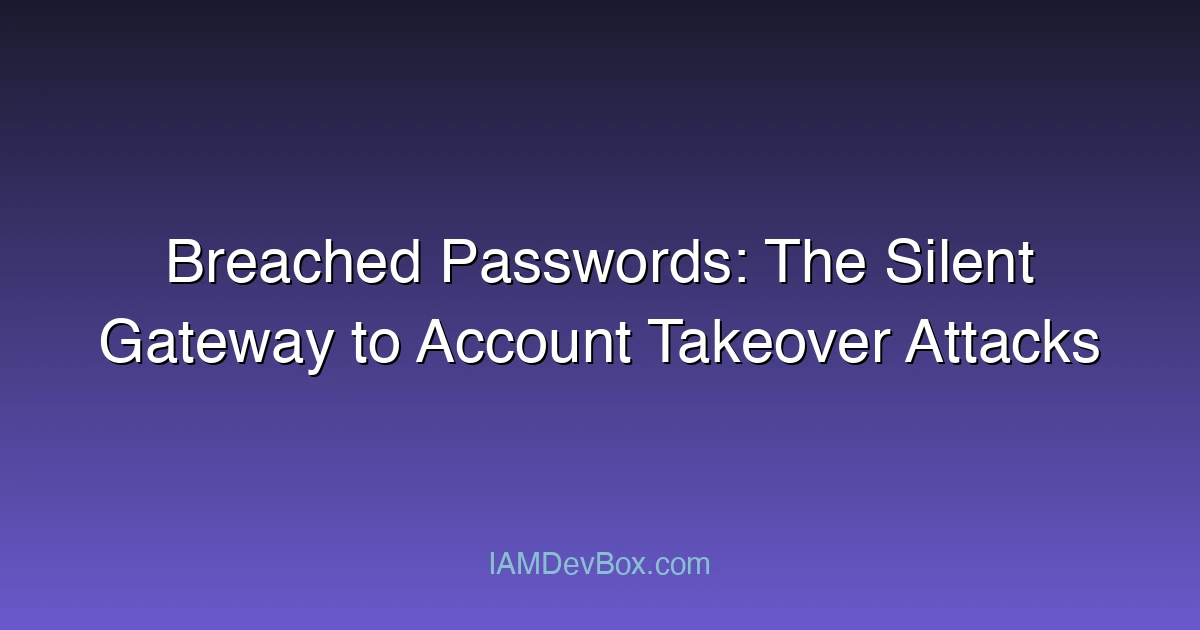Visual Overview:
graph TB
subgraph "Authentication Methods"
Auth[Authentication] --> Password[Password]
Auth --> MFA[Multi-Factor]
Auth --> Passwordless[Passwordless]
MFA --> TOTP[TOTP]
MFA --> SMS[SMS OTP]
MFA --> Push[Push Notification]
Passwordless --> FIDO2[FIDO2/WebAuthn]
Passwordless --> Biometric[Biometrics]
Passwordless --> Magic[Magic Link]
end
style Auth fill:#667eea,color:#fff
style MFA fill:#764ba2,color:#fff
style Passwordless fill:#4caf50,color:#fff
In the ever-evolving landscape of cybersecurity, one threat stands out as particularly insidious: Account Takeover (ATO) attacks. These attacks exploit the widespread use of weak, reused, or breached passwords, enabling attackers to gain unauthorized access to user accounts. Once an attacker controls an account, the consequences can be severe, ranging from financial loss to reputational damage. In this blog post, we’ll delve into how breached passwords pave the way for ATO attacks, explore real-world examples, and discuss strategies to mitigate this growing threat.
The Password Predicament
Passwords remain the cornerstone of digital authentication, despite their well-documented flaws. The problem? Users often reuse the same password across multiple platforms. When one account is compromised in a data breach, attackers can use that password to infiltrate other accounts, a process known as “credential stuffing.”
For example, consider the 2018 Marriott data breach, where attackers accessed the personal information of 500 million guests. Among the stolen data were email addresses and encrypted passwords. Cybercriminals could use these credentials to attempt logins on other platforms, such as banking or e-commerce sites, potentially leading to ATOs.
Diagram: Credential Stuffing in Action
[Account A (Breach)] → [Stolen Credentials] → [Credential Stuffing] → [Account B (ATO)]
How Account Takeover Attacks Work
ATO attacks typically follow a predictable pattern:
- Credential Acquisition: Attackers obtain stolen credentials from data breaches, phishing
Real-World Example: The Twitter Hack of 2020
In July 2020, a coordinated ATO attack compromised high-profile Twitter accounts, including those of Barack Obama, Joe Biden, and Elon Musk. Attackers gained access to Twitter’s internal tools by exploiting compromised employee credentials, which were likely obtained through a phishing campaign. Once inside, they used these tools to take over high-value user accounts and post fraudulent Bitcoin scams. The incident underscored the importance of securing both user and administrative accounts.
The Evolution of ATO Attacks
ATO attacks are not a new phenomenon, but their sophistication and scale have increased significantly in recent years. Attackers now use advanced techniques, such as:
- AI-Powered Credential Stuffing: Machine learning algorithms can optimize credential stuffing attacks by identifying patterns in successful logins.
- Multi-Vector Attacks: Combining ATOs with other attack vectors, such as phishing or social engineering, to increase success rates.
- Monetization-as-a-Service: Cybercriminals can now rent ATO tools and services on darknet marketplaces, lowering the barrier to entry for would-be attackers.
Diagram: The Modern ATO Attack Chain
[Stolen Credentials] → [Automated Credential Stuffing] → [Account Compromise] → [Monetization]
Mitigating Account Takeover Attacks
Organizations and individuals must adopt a proactive approach to combat ATO attacks. Here are some key strategies:
1. Enforce Strong Password Policies
- Require users to create complex, unique passwords.
- Ban the reuse of previously breached passwords.
- Implement password managers to help users generate and store secure passwords.
2. Implement Multi-Factor Authentication (MFA)
MFA adds an extra layer of security by requiring users to provide two or more forms of verification (e.g., a password and a one-time code). Even if an attacker obtains a user’s password, they cannot access the account without the second factor.
3. Monitor for Anomalous Activity
Use advanced analytics and AI-driven security tools to detect suspicious login attempts or behavioral anomalies that may indicate an ATO.
4. Educate Users
Raise awareness about the risks of password reuse and the importance of securing accounts with MFA. Provide users with resources to check if their credentials have been compromised (e.g., haveibeenpwned.com).
5. Secure APIs and Internal Tools
As seen in the Twitter hack, attackers often target internal tools and APIs to gain access to user accounts. Ensure that these systems are secured with robust authentication and authorization mechanisms.
Code Example: Implementing Password Hashing and MFA
Here’s a simple example of how to implement password hashing and MFA in a web application:
# Password Hashing
from passlib.context import CryptContext
pwd_context = CryptContext(schemes=["bcrypt"], deprecated="auto")
def hash_password(password: str) -> str:
return pwd_context.hash(password)
def verify_password(plain_password: str, hashed_password: str) -> bool:
return pwd_context.verify(plain_password, hashed_password)
# MFA Implementation (Simplified)
import pyotp
def generate_otp_secret() -> str:
return pyotp.random_base32()
def verify_otp(token: str, secret: str) -> bool:
totp = pyotp.TOTP(secret)
return totp.verify(token)
Conclusion
Breached passwords are a ticking time bomb, and ATO attacks are the inevitable explosion. Organizations must prioritize password security, implement MFA, and adopt proactive monitoring to stay ahead of cybercriminals. By taking these steps, we can reduce the risk of ATO attacks and protect user accounts from falling into the wrong hands.
Extended Questions for Readers
- How does your organization handle password security and MFA implementation?
- Have you ever experienced an ATO attack? What steps did you take to recover?
- How can businesses better educate users about the risks of password reuse?
Let me know your thoughts in the comments below! 🛡️
